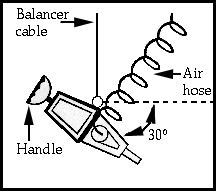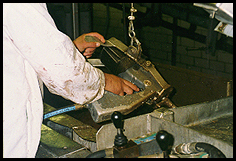Best practices for Cattle and Pig handling and stunning
by Dr. Temple Grandin
Updated January 2012
At the February American Meat Institute Animal Handling and Stunning Conference, the results of the 1999 McDonald's audits were presented ("Managing what you measure," M&P, March 2000, page 58). During visits to 42 beef and pork plants a number of best practices were identified, which were shared with the attendees. Animal handling and stunning greatly improved in 1999 compared to my 1996 U.S. Dept. of Agriculture audit. Following is a list of best practices that will improve animal welfare and help reduce pale, soft, exudative meat; bruises; dark cutters; and blood splash. Additional updates were added in 2012:
- The ergonomics of a heavy pneumatic captive bolt stunner can be improved by adding a handle (Figure 1). On a conveyor restrainer, the stunner should be hung on a 30-degree angle. This will reduce the twisting strain on the wrists. For the Jarvis pneumatic stunner, the angle should be greater, but it should not be straight down vertical.

Figure 1. Pneumatic captive bolt stunner with ergonomic improvements for use in a conveyor restrainer.

Figure 2. Pneumatic captive bolt stunner equipped with an ergonomic handle.
When this stunner is used in a conveyor restrainer it should be hung at an angle.
- Calm animals will move more easily than agitated, excited animals. When animals get agitated they bunch up and stick together.
- Flags made from a 30 inch by 30 inch (76 cm by 76 cm) square of light, plasticized tarp cloth are good for moving pigs. Pigs move away from the rustling cloth.
- To prevent guillotine gates from bruising on the back, replace the bottom 18 inches (46 cm) of the gate with a piece of conveyor belting. The pigs will think the conveyor belt curtain is solid and they will not go through it.
- A vibrating prod can be made from a pneumatic powered engraving tool mounted in a handle. The sharp tip has to be removed. When it is properly constructed, it creates an intense vibration that did not hurt a person's arm.
- Fill the crowd pen leading to the single file chute and the staging area half full with cattle or pigs. Animals need room to turn. Use natural following behavior by allowing the leadup race to become partially empty before filling the crowd pen. This enables the animlas to quietly pass through the crowd pen without stopping.
- A plastic wastebasket liner on a stick works well for turning cattle in the crowd pen. Be careful with this driving aid and do not aggressively wave it. Use it to quietly guide cattle. Often very small movements of the stick will turn or move the animals.
- Illuminate the entrance of the conveyor restrainer. The light must be directed into the entrance of the restrainer. It must not shine into the eyes of approaching cattle or pigs. Animals will balk at a dark entrance.
- A small stiff bristle scrub brush on a stick works well for moving pigs in single file races.
- If animals balk at a reflection on the floor of a chute, try moving the ceiling lights off the centerline of the chute. Moving a light will often eliminate a reflection. You can also experiment with covering a light.
- Conveyor restrainers for both cattle and pigs should have a false floor mounted under the restrainer. This prevents the animal from balking at seeing the "visual cliff effect." The false floor provides the illusion of a solid floor to walk on, but the animal's feet must not touch it.
- On a pneumatic stunner, install an easy to reach water spray to clean the trigger mechanism; Regular cleaning will help prevent misfiring.
- Cartridges for a cartridge-fired stunner should be kept in a dry place. Storage in a damp location can result in misfiring. One suggestion is to shrink-wrap boxes of cartridges held in storage or store them in a dry office.
- Cartridge-fired stunners must be rotated often to prevent overheating. Build a rack on the wall or side of the chute to hold the stunners to make rotation easier.
- Electric prods should not be constantly carried by handlers. A flag, paddle stick, plastic bag, or vibrating prod should be the primary tool for moving animals. The electric prod should only be used to move an animal that balks. In most plants the only place where an electric prod may be occasionally be needed is at the entrance to a stun box or a restrainer. Electric prods should not be used for unloading trucks.
- If a powered gate is used to move animals, it should be controlled by an operator pushing a switch. Fully automated gates in the crowd pen leading to the single file chute often lead to pile ups. The operator must be able to control the gate. Powered gates should not knock over animals or skid them along the floor.
- Chutes should be designed to reduce clanking and rattling. In a pork plant, the doors for removing downed pigs should be designed so they do not clatter and make noise when pigs bump against them.
- People should stop whistling and yelling. High-pitched sounds from people yelling agitates the animals.
- Pork producers should walk in the pens every day during finishing. This will help make the pigs easier to handle at the plant. This is especially important for lean hybrid pigs with an excitable temperament. Producers should also adjust their practices to reduce problems with lame pigs, fatigued pigs, or overuse of beta-agonists.
- Eliminate the injection of air into the brain by a stunner.
 Click here to return to the Homepage for more information on animal behavior, welfare, and care.
Click here to return to the Homepage for more information on animal behavior, welfare, and care.


